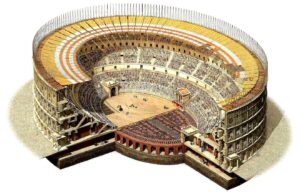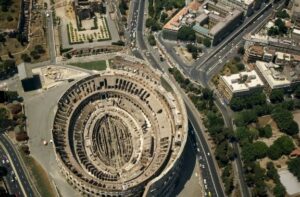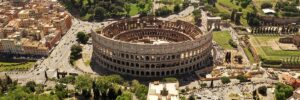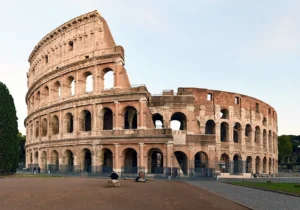Il Colosseo, originariamente conosciuto come Anfiteatro Flavio (in latino Amphitheatrum Flavium) o sempliceme

nte Amphitheatrum (in italiano: Anfiteatro), è il più grande anfiteatro romano del mondo (in grado di contenere un numero di spettatori stimato tra 50 000 e 87 000), situato nel centro della città di Roma. È il più importante anfiteatro romano, nonché il più imponente monumento dell’antica Roma che sia giunto fino a noi.
Inserito nel 1980 nella lista dei Patrimoni dell’umanità dell’UNESCO – insieme all’intero Centro storico di Roma, alle Zone extraterritoriali della Santa Sede in Italia e alla Basilica di San Paolo fuori le mura – nel 2007, unico monumento europeo, è stato anche inserito fra le Nuove sette meraviglie del mondo a seguito di un concorso organizzato da New Open World Corporation (NOWC).
L’anfiteatro fu edificato in epoca Flavia su un’area al limite orientale del Foro Romano. La sua costruzione, iniziata da Vespasiano nel 70 d.C., fu conclusa da Tito, che lo inaugurò il 21 aprile nell’80 d.C. Ulteriori modifiche vennero apportate durante l’impero di Domiziano, nel 90 d.C.

L’edificio forma un ovale policentrico di 527 m di perimetro, con assi che misurano 187,5 e 156,5 m. L’arena all’interno misura 86 × 54 m, con una superficie di 3357 m². L’altezza attuale raggiunge 48 m, ma originariamente arrivava a 52 m. La struttura esprime con chiarezza le concezioni architettoniche e costruttive romane della prima Età imperiale, basate rispettivamente sulla linea curva e avvolgente offerta dalla pianta ellittica e sulla complessità dei sistemi costruttivi. Archi e volte sono concatenati tra loro in un serrato rapporto strutturale.
Il nome “Colosseo” si diffuse solo nel Medioevo, e deriva dalla deformazione popolare dell’aggettivo latino “colosseum” (traducibile in “colossale”, come appariva nell’Alto Medioevo tra le casette a uno o due piani)o, più probabilmente, dalla vicinanza della colossale statua acrolitica di Nerone che sorgeva nei pressi. Presto l’edificio divenne simbolo della città imperiale, espressione di un’ideologia in cui la volontà celebrativa giunge a definire modelli per lo svago e il divertimento del popolo.
Anticamente era usato per gli spettacoli dei gladiatori e altre manifestazioni pubbliche (spettacoli di caccia, battaglie navali, rievocazioni di battaglie famose e drammi basati sulla mitologia classica). Non più in uso dopo il VI secolo, l’enorme struttura venne riutilizzata nei secoli, anche come cava di materiale. Oggi è un simbolo della città di Roma e una delle maggiori attrazioni turistiche sotto forma di monumento archeologico regolarmente visitabile.

The Colosseum, originally known as the Flavian Amphitheatre (in Latin Amphitheatrum Flavium) or simply Amphitheatrum (in Italian: Anfiteatro), is the largest Roman amphitheatre in the world (able to hold an estimated 50,000 to 87,000 spectators), located in the centre of the city of Rome. It is the most important Roman amphitheatre, as well as the most impressive monument of ancient Rome that has come down to us.
Included in the list of UNESCO World Heritage Sites in 1980 – together with the entire Historic Centre of Rome, the Extraterritorial Zones of the Holy See in Italy and the Basilica of Saint Paul Outside the Walls – in 2007, the only European monument, it was also included among the New Seven Wonders of the World following a competition organised by New Open World Corporation (NOWC).
The amphitheatre was built in the Flavian era on an area on the eastern edge of the Roman Forum. Its construction, begun by Vespasian in 70 AD, was completed by Titus, who inaugurated it on April 21, 80 AD. Further modifications were made during the reign of Domitian, in 90 AD.
The building forms a polycentric oval with a perimeter of 527 m, with axes measuring 187.5 and 156.5 m. The arena inside measures 86 × 54 m, with a surface area of 3357 m². The current height reaches 48 m, but originally reached 52 m. The structure clearly expresses the Roman architectural and construction concepts of the early Imperial Age, based respectively on the curved and enveloping line offered by the elliptical plan and on the complexity of the construction systems. Arches and vaults are linked together in a close structural relationship.
The name “Colosseum” became widespread only in the Middle Ages, and derives from the popular deformation of the Latin adjective “colosseum” (translatable as “colossal”, as it appeared in the Early Middle Ages among the one- or two-story houses) or, more likely, from the proximity of the colossal acrolithic statue of Nero that stood nearby. Soon the building became a symbol of the imperial city, an expression of an ideology in which the celebratory will comes to define models for the entertainment and enjoyment of the people.
In ancient times it was used for gladiator shows and other public events (hunting shows, naval battles, re-enactments of famous battles and dramas based on classical mythology). No longer in use after the 6th century, the enormous structure was reused over the centuries, even as a quarry. Today it is a symbol of the city of Rome and one of the major tourist attractions in the form of an archaeological monument that can be visited regularly.
